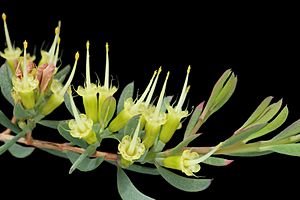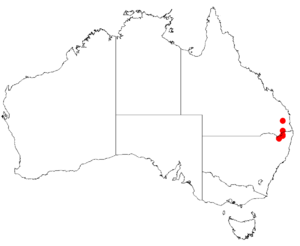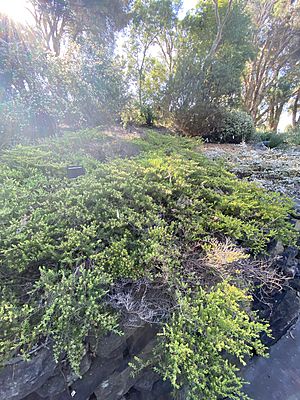Crescent-leaved homoranthus facts for kids
Quick facts for kids Crescent-leaved homoranthus |
|
|---|---|
 |
|
| Homoranthus lunatus in the ANBG | |
| Scientific classification | |
| Genus: |
Homoranthus
|
| Species: |
lunatus
|
 |
|
| Occurrence data from AVH | |
Homoranthus lunatus is a special plant that belongs to the myrtle family, called Myrtaceae. It is only found in a small area in northern New South Wales, Australia. This plant is a spreading shrub. It has unique curved leaves and small groups of yellow flowers. These flowers grow where the leaves meet the stem, which is called a leaf axil.
Contents
About the Plant
This plant is a type of shrub. It spreads out rather than growing straight up. Its leaves are quite interesting because they are curved. The flowers of Homoranthus lunatus are yellow. They grow in small groups, with up to six flowers together. You can usually see this plant flowering from July to November. Its fruits appear a bit later, from August to December.
Plant Name and History
How it got its name
The plant Homoranthus lunatus was officially named in 1991. Two scientists, Lyndley Craven and S.R.Jones, described it for the first time. Their description was published in a science journal called Australian Systematic Botany.
Meaning of lunatus
The second part of its scientific name, lunatus, is a Latin word. It means "shaped like a crescent moon". This name likely describes the curved shape of the plant's leaves.
Where it Lives
Its home in New South Wales
Homoranthus lunatus is very rare. It is only found in a few specific places in New South Wales. These areas include the Torrington district. You can also find it in Boonoo Boonoo and Basket Swamp National Parks. These parks are located north-east of Tenterfield.
Its preferred environment
This plant likes to grow in areas called heathlands. Heathlands are open areas with low-growing shrubs. It prefers shallow, sandy soils. You will often find it growing on or near granite rocks.
Protecting the Plant
Why it needs protection
Because Homoranthus lunatus is found in such a small area, it is considered a vulnerable plant. This means it is at risk of disappearing if its habitat is disturbed. Scientists like Briggs and Leigh noted its vulnerable status in 1996. It is important to protect this plant to make sure it continues to thrive in its natural home.


